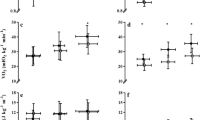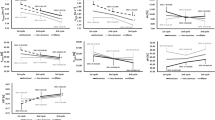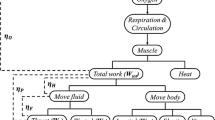Summary
The purpose of this study was to examine the relationship between the energy cost of swimming per unit distance (CS) at different velocities (ν) and performance level, body size and swimming technique in women. A total of 58 females swimmers were studied. Three performance levels (A, B, C) were determined, ranging from the slower (A) to the faster (B, C). At level C and at 1.1 m·s−1, Cs,1.1 was reduced by 7% when directly compared to level B. The Cs,1.1 was reduced by 10% when calculated per unit of height (h) and by 37% when calculated per unit ofh and hydrostatic lift (HL). For the whole group of swimmers, the equation regression was Cs, 1.1 = 0.27h −2.38 HL−7.5 (r=0.53,P<0.01). To evaluate the specific influence of arm length two groups of long- and short-armed swimmers were selected among swimmers of similarh and performance. The Cs was significantly higher (P<0.05) by 12%, SD 2.2%, for short-armed than for long-armed swimmers. To evaluate the influence of different types of swimming technique, two other groups of similar performance and anthropometric characteristics were selected. The Cs was significantly higher (P<0.05) by 12%, SD 4.5% for swimmers using for preference their legs rather than their arms. The Cs of the sprinters was 15.7%, SD 2% higher than that of the long-distance swimmers. For all groups, CS increased withv on average by 8% to 11% every 0.1 m · s−1. These findings showed that Cs variations of these women were close to those previously demonstrated for men. The Cs depends on performance level, body size, buoyancy, swimming technique and ν.
Similar content being viewed by others
References
Cazorla G, Montpetit R (1988) Metabolic and cardiac responses of swimmers, modern pentathletes and water polo players during freestyle swimming to a maximum. In: Ungerechts BE, Wilke K, Reischle K (eds) Swimming science V. Human Kinetics, Champaign, Ill., pp 251–257
Chatard JC, Lavoie JM, Lacour JR (1990) Analysis of determinants of swimming economy in front crawl. Eur J Appl Physiol 61:88–92
Costill DL, Kovaliski J, Porter D, Fielding R, King D (1985) Energy expenditure during front crawl swimming: predicting success in middle distance events. Int J Sports Med 6:266–270
Du Bois D, Du Bois EF (1916) Clinical calorimetry. A formula to estimate the approximate surface area if height and weight be known. Arch Intern Med 17:863–871
Holmer I (1974) Physiology of swimming man. Acta Physiol Scand [Suppl] 407:1–55
Hollander AP, Groot G de, van Ingen Schenau GJ, Kahman R, Toussaint HM (1988) Contribution of the legs to propulsion in front crawl swimming. In: Ungerechts BE, Wilke K, Reischle K (eds) Swimming science V. Human Kinetics, Champaign, Ill., pp 39–44
Kearney JT, Van Handel PJ (1989) Economy: a physiologic perspective. In: Grana WA (ed) Advances in sports medicine and fitness. Year Book Medical Publishers, Chicago, pp 57–88
Montpetit R, Léger L, Lavoie JM, Cazorla G (1981) 16-1 peak during free swimming using the backward extrapolation of the recovery curve. Eur J Appl Physiol 47:385–391
Montpetit R, Lavoie JM, Cazorla G (1983) Aerobic energy cost of the front crawl at high velocity in international class and adolescent swimmers. In: Hollander AP, Huijing PA, de Groot G (eds) Biomechanics and medicine in swimming. Human Kinetics, Champaign, Ill., pp 228–234
Montpetit R, Cazorla G, Lavoie JM (1988) Energy expenditure during front crawl swimming: a comparison between males and females. In: Ungerechts BE, Wilke K, Reischle K (eds) Swimming science V. Human Kinetics, Champaign, Ill., pp 229–236
Pendergast DR, Prampero PE di, Craig AB, Wilson DR, Rennie DW (1977) Quantitative analysis of the front crawl in men and women. J Appl Physiol 43:475–479
Van Handel PA, Katz A, Morrow JR, Troup JP, Daniels JT, Bradley PW (1988) Aerobic economy and competitive performance of U.S. elite swimmers. In: Ungerechts BE, Wilke K, Reischle K (eds) Swimming science V. Human Kinetics, Champaign, Ill., pp 219–227
Author information
Authors and Affiliations
Rights and permissions
About this article
Cite this article
Chatard, J.C., Lavoie, J.M. & Lacour, J.R. Energy cost of front-crawl swimming in women. Europ. J. Appl. Physiol. 63, 12–16 (1991). https://doi.org/10.1007/BF00760794
Accepted:
Issue Date:
DOI: https://doi.org/10.1007/BF00760794




